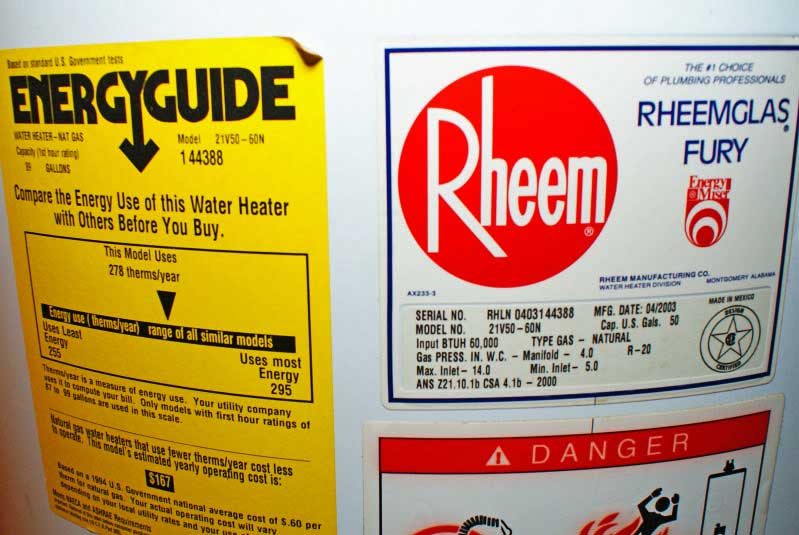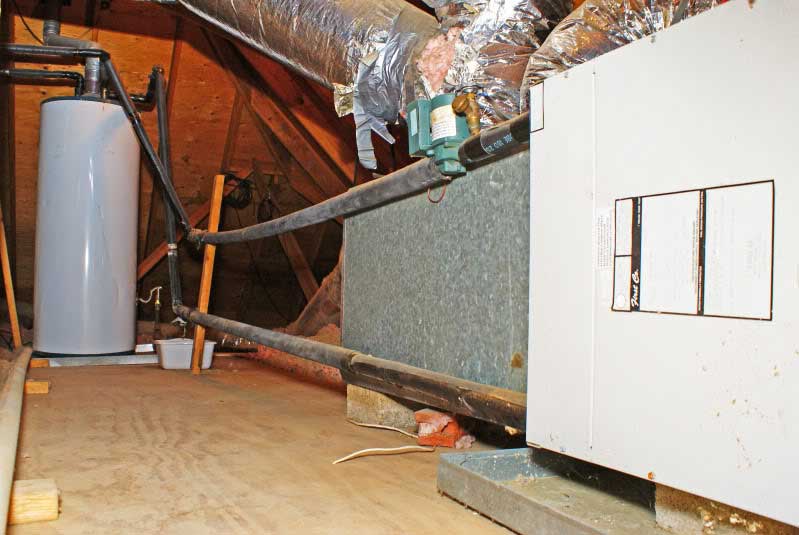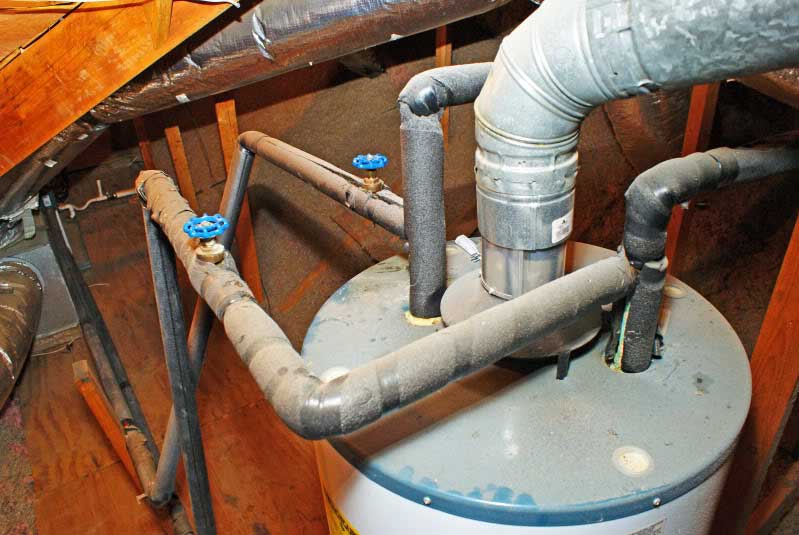I am in the process of replacing my water heater and like anything I do I first research, research, research....
A little back ground...
I currently have a 50 gal. nat. gas Rheem water heater. While supplying the hot water to all of the plumbing fixtures in the house, it also does double duty, supplying hot water to my heater. The heater is a First Co. Aquatherm "Combo Heater".
Specifically the water heater is...
Rheemglas Fury 50gal
Model # 21V50-60N
Input BTU of 60,000
FHR of 89 gallons
The "Combo Heater" is...
First Company
Model # 36MBXB-HW
Max heat output 51,100 BTU @ 140* water temp
Max inlet water temp of 180*
Air handler of approx. 1200 CFM (best guess according to literature from the First Co. website)
Flow rate of hot water through unit approx. 4 GPM (best guess according to literature from the First Co. website)
From what I could gather (also from the website), the water returning to the the water heater has a heat loss of 10 -20 degrees.
The home...
2 adults and 1 (for now) child (16 months old)
3 sinks (1 kitchen, 2 bathroom)
2 bathtubs
1 shower
1 dishwasher
1 clothes washer
1 heater**
The home is located near Memphis, TN so it is a mixed cooling/heating climate.
I am wanting to replace the water heater for several reasons...
1) I have a leak somewhere on the return line to the w.h. from the heater caused by...
1a) inadequate bracing of copper lines between w.h. and heater.
1b) inadequate "flooring" beneath the w.h. (I can rock the w.h. back and forth with ease because the sheathing used is so thin.)
2) Pipes have corrosion at other joints.
3) The water heater is full of sediment (I think). After using hot water and the burner fires up you can hear a loud noise. I assume this to be sediment "boiling" in the bottom of the tank.
4) A couple of years ago I was having trouble keeping the pilot lit. I put 2 new thermocouples in it with no luck. I ended up turning the temp up quite a bit and it hasn't gone out since.
5) In the winter while heating the house taking 2 showers back to back usually the second shower starts to go cold. From living in the house for 4 years it seems the heater would work more efficiently with a better water heater.
6) The water heater is nearly 9 years old



Obviously I need a new water heater that at the very least matches the specs of the current one. My biggest consideration being the fact it has to supply hot water for the heater in the winter.
While looking a the First Co. website I came across the following info for sizing a water heater to use with the heater...
""Proper water heater sizing should consider both the gallon capacity AND the BTU input of the water heater.
To determine water heater GALLON CAPACITY: A minimum 40 gallon high recovery and/or high efficiency gas or oil-fired water heater is recommended. The following volume sizing guide is satisfactory in most areas of the country:
600-800 CFM air handlers - Minimum 40 gallon water heater
1000-1200 CFM air handlers - Minimum 50 gallon water heater
1400-1600 CFM air handlers - Either two 40 gallon water heaters piped together, one high input 50 gallon (63,000 to 75,000 BTU input), or one 72 to 75 gallon
2000 CFM air handlers -Any combination of water heaters having at least 105,000 BTU OUTPUT.
To determine water heater BTU INPUT: (Assumes a water heater recovery efficiency of 76%). For mild climates...BTU INPUT = structure's heat loss x 1.51. For colder climates...BTU INPUT = structure's heat loss x 1.58.""
Calculating the heat loss of my house is way over my head, so looking at the old heater ( and knowing it is just barely enough to do the job), and the above info...
I think I need a water heater with at least...
50 gal
60,000 BTU input
FHR of 90
Through much of my reading I am most interested in Bradford White, with Rheem/Rudd a close second.
I have been looking and have come across several water heaters I am interested in...
1) Bradford White M-2-XR504T6FBN 48 gal. Extra Recovery
65,000 BTU input
FHR of 101
Recovery of 69 GPH
Recovery Efficiency of 79%
2) Bradford White M-2-XR65T6FBN 65 gal. Extra Recovery
65,000 BTU input
FHR of 126
Recovery of 69 GPH
Recovery Efficiency of 79%
3) Bradford White GX-2-25S6BN 25 gal. High Performance
78,000 BTU input
FHR of 155
Recovery of 84 GPH
Recovery Efficiency of 82%
***I am guessing even with the great specs that the 25 gallon capacity is too small right?
4) Bradford White GX-1-55S6BN 55 gal. High Performance
80,000 BTU input
FHR of 200
Recovery of 86 GPH
Recovery Efficiency of 82%
Sorry for such a long post. Any and all advice is very welcome.
Thanks, Stephen
A little back ground...
I currently have a 50 gal. nat. gas Rheem water heater. While supplying the hot water to all of the plumbing fixtures in the house, it also does double duty, supplying hot water to my heater. The heater is a First Co. Aquatherm "Combo Heater".
Specifically the water heater is...
Rheemglas Fury 50gal
Model # 21V50-60N
Input BTU of 60,000
FHR of 89 gallons
The "Combo Heater" is...
First Company
Model # 36MBXB-HW
Max heat output 51,100 BTU @ 140* water temp
Max inlet water temp of 180*
Air handler of approx. 1200 CFM (best guess according to literature from the First Co. website)
Flow rate of hot water through unit approx. 4 GPM (best guess according to literature from the First Co. website)
From what I could gather (also from the website), the water returning to the the water heater has a heat loss of 10 -20 degrees.
The home...
2 adults and 1 (for now) child (16 months old)
3 sinks (1 kitchen, 2 bathroom)
2 bathtubs
1 shower
1 dishwasher
1 clothes washer
1 heater**
The home is located near Memphis, TN so it is a mixed cooling/heating climate.
I am wanting to replace the water heater for several reasons...
1) I have a leak somewhere on the return line to the w.h. from the heater caused by...
1a) inadequate bracing of copper lines between w.h. and heater.
1b) inadequate "flooring" beneath the w.h. (I can rock the w.h. back and forth with ease because the sheathing used is so thin.)
2) Pipes have corrosion at other joints.
3) The water heater is full of sediment (I think). After using hot water and the burner fires up you can hear a loud noise. I assume this to be sediment "boiling" in the bottom of the tank.
4) A couple of years ago I was having trouble keeping the pilot lit. I put 2 new thermocouples in it with no luck. I ended up turning the temp up quite a bit and it hasn't gone out since.
5) In the winter while heating the house taking 2 showers back to back usually the second shower starts to go cold. From living in the house for 4 years it seems the heater would work more efficiently with a better water heater.
6) The water heater is nearly 9 years old



Obviously I need a new water heater that at the very least matches the specs of the current one. My biggest consideration being the fact it has to supply hot water for the heater in the winter.
While looking a the First Co. website I came across the following info for sizing a water heater to use with the heater...
""Proper water heater sizing should consider both the gallon capacity AND the BTU input of the water heater.
To determine water heater GALLON CAPACITY: A minimum 40 gallon high recovery and/or high efficiency gas or oil-fired water heater is recommended. The following volume sizing guide is satisfactory in most areas of the country:
600-800 CFM air handlers - Minimum 40 gallon water heater
1000-1200 CFM air handlers - Minimum 50 gallon water heater
1400-1600 CFM air handlers - Either two 40 gallon water heaters piped together, one high input 50 gallon (63,000 to 75,000 BTU input), or one 72 to 75 gallon
2000 CFM air handlers -Any combination of water heaters having at least 105,000 BTU OUTPUT.
To determine water heater BTU INPUT: (Assumes a water heater recovery efficiency of 76%). For mild climates...BTU INPUT = structure's heat loss x 1.51. For colder climates...BTU INPUT = structure's heat loss x 1.58.""
Calculating the heat loss of my house is way over my head, so looking at the old heater ( and knowing it is just barely enough to do the job), and the above info...
I think I need a water heater with at least...
50 gal
60,000 BTU input
FHR of 90
Through much of my reading I am most interested in Bradford White, with Rheem/Rudd a close second.
I have been looking and have come across several water heaters I am interested in...
1) Bradford White M-2-XR504T6FBN 48 gal. Extra Recovery
65,000 BTU input
FHR of 101
Recovery of 69 GPH
Recovery Efficiency of 79%
2) Bradford White M-2-XR65T6FBN 65 gal. Extra Recovery
65,000 BTU input
FHR of 126
Recovery of 69 GPH
Recovery Efficiency of 79%
3) Bradford White GX-2-25S6BN 25 gal. High Performance
78,000 BTU input
FHR of 155
Recovery of 84 GPH
Recovery Efficiency of 82%
***I am guessing even with the great specs that the 25 gallon capacity is too small right?
4) Bradford White GX-1-55S6BN 55 gal. High Performance
80,000 BTU input
FHR of 200
Recovery of 86 GPH
Recovery Efficiency of 82%
Sorry for such a long post. Any and all advice is very welcome.
Thanks, Stephen
